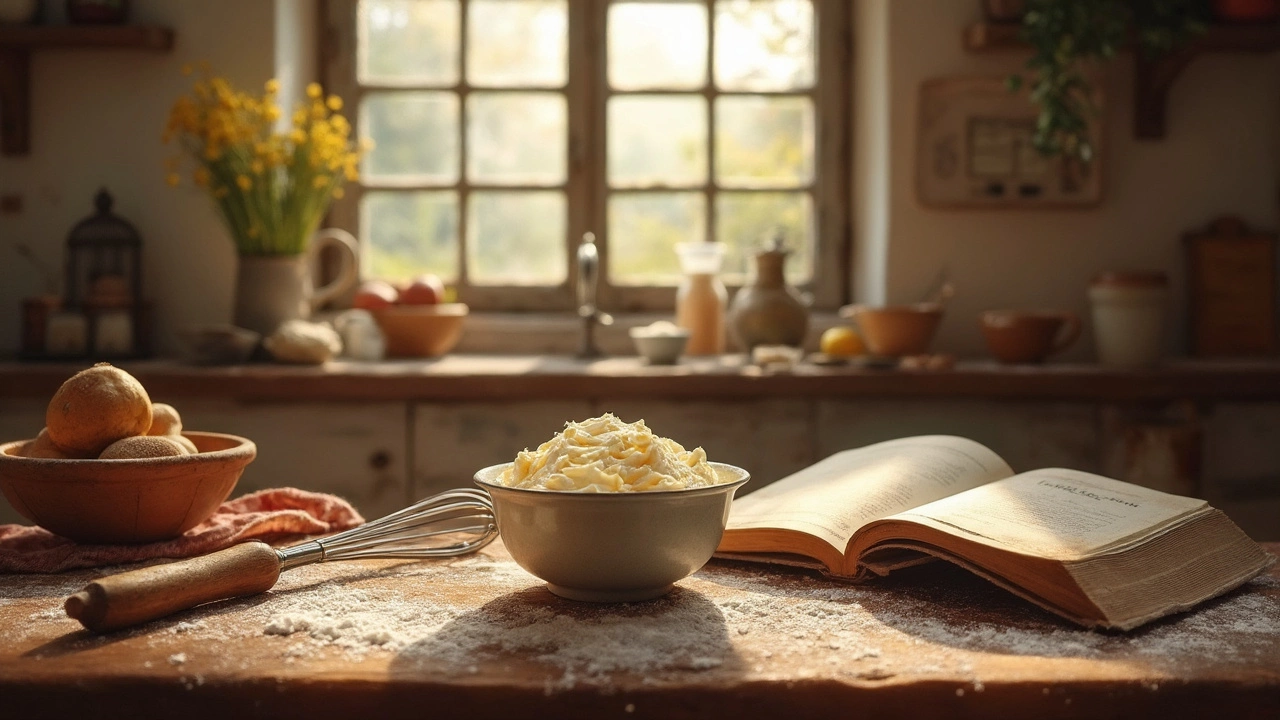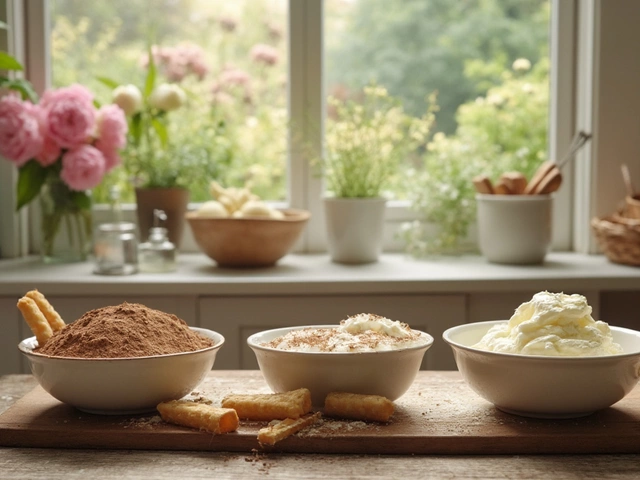
Ever wondered why tiramisu tastes so heavenly? The secret's in the cheese, my friend. Mascarpone is that velvety magic that turns an ordinary dessert into something divine. You won't find it just anywhere; this special cream cheese is a treasure from Italy, made by adding citric or acetic acid to cream. Think of mascarpone as cream cheese’s fancy cousin—one that's creamier and richer, giving tiramisu its signature smooth texture.
This cheese isn’t only about taste but also about history. Originating in the Lombardy region of Italy, mascarpone dates back to the late 16th or early 17th century. It's been charming taste buds for centuries, not just in desserts but also in savory dishes. Imagine using it in creamy pasta sauces or spreading it on crusty bread with figs and honey.
- Introduction to Mascarpone
- History and Origin
- Mascarpone in Tiramisu
- Other Uses for Mascarpone
- Tips for Buying and Storing
Introduction to Mascarpone
Let's unravel the creamy mystery of mascarpone. This cheese is more than just a culinary gem; it's an essential ingredient for anyone eager to whip up a classic tiramisu. Mascarpone is a bit like cream cheese but taken up a notch in richness and smoothness. It's what makes tiramisu's texture irresistible and every bite super satisfying.
Made from whole cream, mascarpone is crafted by adding an acid—often citric or tartaric—to thicken and solidify the cream. The process results in a creamy, slightly sweet cheese that's versatile beyond belief. In grocery stores, you typically find mascarpone in the cheese aisle, packaged similarly to other soft cheeses.
What Sets Mascarpone Apart?
What really sets mascarpone apart from similar cheeses is its texture and flavor. It's less tangy than cream cheese, making it perfect for bringing a luxurious creaminess without overshadowing other ingredients in a dish. Plus, its higher fat content is what gives it that signature decadence.
Where Can You Find It?
In New Zealand, and especially here in Auckland, you can find mascarpone in most supermarkets and specialty cheese shops. It's usually located near other gourmet cheeses or sometimes in the dairy aisle next to cream cheese. Pro tip: always check the expiration date to ensure freshness.
Key Points to Remember
- Mascarpone is a fresh cream cheese, not aged like other traditional cheeses.
- Its creamy, smooth texture makes it ideal for desserts, especially tiramisu, but also works beautifully in savory dishes.
- Originally from Lombardy, Italy, it's been enhancing dishes across the globe.
So, next time you're planning to make a homemade tiramisu or a lusciously creamy sauce, you know what cheese to grab. It's all about that perfect balance of richness and mild sweetness that mascarpone brings to the table.
History and Origin
The story of mascarpone is rooted in the rich culinary tapestry of Italy, particularly the lush region of Lombardy. Somewhere between the end of the 16th and the beginning of the 17th century, this creamy cheese first began to take shape, becoming a beloved staple in Italian kitchens.
The exact origins are a bit of a mystery, like many food legends, but we do know that its name probably comes from the Spanish 'mascarpa,' which refers to a type of ricotta-like cheese. This hints at the cross-cultural influences of the time, blending practices and tastes across borders.
Cheese lovers will appreciate how mascarpone starts its journey from simple cream. The Lombardic cheesemakers would gently heat the cream and curdle it using natural acids like lemon juice or acetic acid. This process results in an exceptionally smooth and lush consistency that makes mascarpone unique.
Not just a product of tradition, mascarpone quickly found fans across Italy and beyond. It wasn't just for desserts; locals would slather it onto bread or mix it in savory dishes. But of course, its claim to worldwide fame came with its key role in tiramisu, the classic dessert that continues to win hearts and taste buds around the globe.
Interestingly, Italy produces over 65 million kilograms of mascarpone annually, a testament to its enduring popularity. It's not just an ingredient; it symbolizes Italian culinary artistry advancing tradition through innovation.

Mascarpone in Tiramisu
When you take a bite of tiramisu, it's the mascarpone that gives it that creamy richness we all love. This cheese is the backbone of the dessert, providing not just texture but a mild sweetness that balances the bitterness of the coffee and cocoa.
The traditional tiramisu recipe calls for layering mascarpone between coffee-soaked ladyfingers. This method ensures that every forkful is a harmonious blend of flavors and textures. Mascarpone's thick, yet light consistency allows it to blend easily with eggs and sugar, creating the luscious layers characteristic of a perfect tiramisu.
Why Mascarpone?
So, why is mascarpone the go-to cheese for this dessert? It's simple: no other cheese captures the balance of creaminess and subtle flavor that tiramisu needs. Unlike other cheeses, mascarpone doesn't overpower other ingredients. Instead, it enhances them, bringing out their best qualities without stealing the spotlight.
Mixing the Perfect Cream
Creating the mascarpone mixture for tiramisu is straightforward yet essential. You usually whisk together egg yolks and sugar until smooth, fold in the mascarpone, and sometimes add whipped cream for extra fluffiness. The trick is in the folding—you want that mixture light and airy, so take your time!
If you're health-conscious or experimenting, you might be tempted to use a mascarpone substitute. But for authentic taste and texture, stick with the real deal.
A Little Mascarpone Math
| Ingredient | Amount (grams) |
|---|---|
| Mascarpone | 250 |
| Egg Yolks | 3 |
| Sugar | 80 |
| Whipped Cream | 100 (optional) |
This basic tool-check shows how mascarpone fits into a classic tiramisu mix. It's this precise balance that ensures each piece is as delightful as the last.
Whether you're a tiramisu pro or a first-timer, understanding the role of mascarpone is your ticket to dessert success. So next time you whip up this classic, you'll know what makes it truly special!
Other Uses for Mascarpone
You might know mascarpone from its star role in tiramisu, but this versatile cheese can do a whole lot more in the kitchen. Let's dive into some other ways you can enjoy its creamy goodness.
Spreading the Love
Start your day on a delicious note by spreading mascarpone on your morning toast. It's smooth as butter and pairs beautifully with sweet jams or a drizzle of honey. Feeling fancy? Add a layer of fresh berries on top.
Savory Dishes
Mascarpone isn’t just for dessert. Stir it into your favorite pasta sauce for an instant creamy boost. It works magic in risottos, melting perfectly into the rice for that dreamy texture. A little bit of mascarpone can turn a humble vegetable soup into a creamy delight.
"Mascarpone's rich texture and mild flavor make it a favorite ingredient in both sweet and savory recipes." – Chef Mark Vetri
Quick Desserts
If you're short on time, mascarpone helps you whip up simple desserts in no time. For a fruity treat, mix mascarpone with a bit of sugar and vanilla, then spoon it over sliced peaches, apples, or whatever fruit you have on hand.
- Cheesecake Alternative: Use mascarpone instead of cream cheese for a lighter, softer cheesecake.
- Frosting Upgrade: Mix mascarpone with a bit of powdered sugar for a decadent, easy frosting.
The Cheese Plate
Last but not least, include mascarpone in your cheese board lineup. It's excellent with nuts, figs, or a nice, crusty baguette. And there you have it—you don’t need to be a dessert connoisseur to appreciate mascarpone. This creamy cheese can elevate every meal, and once you start using it, you'll wonder how you ever lived without it.

Tips for Buying and Storing Mascarpone
Tracking down the perfect mascarpone can be a bit of a quest, but it's worth it. Here’s what you need to know to ensure you’re getting the best bang for your buck.
Buying Tips
- Check the Label: Make sure it says 100% pure mascarpone. Avoid brands with unnecessary additives or preservatives.
- Inspect the Dates: Freshness is key. Look for the latest sell-by date and pick refrigerated options to ensure quality.
- Local vs. Imported: While imported Italian mascarpone is a treat, local creameries often offer fresh options that are just as good. Give them a try!
- Fat Content: True mascarpone should have a rich fat content. If you're seeking indulgence, check that it’s got at least 40% fat.
Storing Tips
Got your hands on some creamy gold? Here’s how to keep it fresh and fabulous:
- Refrigeration is Key: Always store mascarpone in the fridge. If you've cracked open the container, ensure it's sealed tightly to prevent contamination.
- Use Quickly: Once opened, try to use mascarpone within a week. Its freshness and flavor peak soon after it's exposed to air.
- Freezing is Optional: In a pinch, mascarpone can be frozen for up to two months. Remember, freezing it might alter the texture, so it’s best used in cooked dishes afterward.
- Airtight Containers: If transferring to another container, pick one that's airtight to prevent it from soaking up other fridge smells.
Whether you're a tiramisu enthusiast or just exploring this versatile cheese, these tips should help you maximize your mascarpone experience. Armed with this know-how, you’re ready to elevate your culinary adventures!











Write a comment